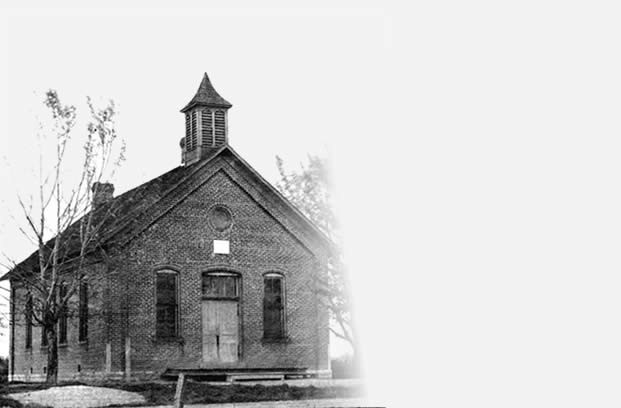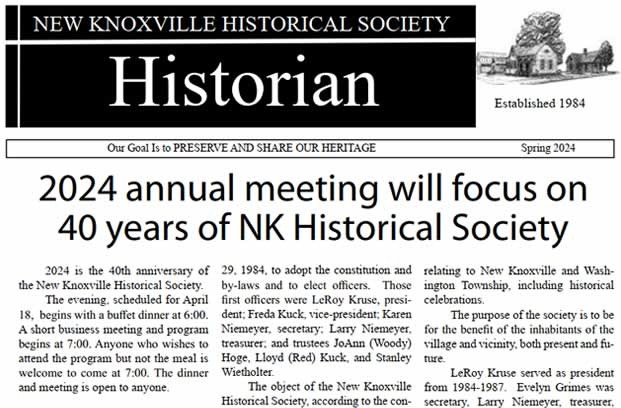Wm. H. Henschen, Andrew Kay’s First Teacher, Recalls Days Of Boxwell Examinations; Began Teaching After Finishing Lower Grades and Short Term of Normal School at College
Today it becomes our privilege to acquaint you with the gentleman who taught us our A. B. C.’s. He is William H. Henschen, R.F.D. 3, St. Marys, residing about three miles southeast of St. Marys. He was born on Decoration Day in 1879 and so will be 71 on May 30th. He continues in good health, continues mentally alert, has prospered at farming and is happy in his family circle. Of course I’ll never forget him. He was my first teacher. It was at Chapel School, District Number 9, Washington Township.
I can still see the chart on the middle section of the blackboard where we first learned to read. There were pictures on it, and short sentences. I distinctly recall “I see a boy. I see a girl. Can the girl see the boy?” Page two read: “Nan has a rat. The rat is in a trap.” We didn’t know anything about grades in those days. We had First Reader (McGuffeys), Second, Third—and up to Fifth or Sixth: A-Arithmetic, B-Arithmetic, C-Arithmetic: A-Language, B-Language, Grammar, Orthography; A-Geography, B-Geography; A-History and B-History, A-Spelling and B-Spelling etc. The big seats for the older pupils were in the back, the seats for the small fry were up front. The big square heating stove was in the middle of the room. On cold winter days, shivering pupils in the far corner would sometimes raise their hands and ask “Teacher, May I sit by the stove?”
As you faced the front, the girls were on the right side of the room and the boys on the left (like the sheep and the goats). Punishment for the boys, when misbehaved, would often be “You must sit with the girls!” That worked fine, up to a certain age. But there would come a time when the older boys would deliberately perpetuate mischief to gain the privilege of sitting with the girls. Recess was play time. Most of the pupils of necessity carried their lunch. The lunch pail must have been well stocked, for they usually had a snack for morning recess, then their noonday lunch, and, unless they were too hungry, they would leave something for “last recess”. Mr. Henschen would come out and play with us, including such games as “Black Man”, “Long Ball”, “Fox and Goose”, “Prisoners Base”,”Andy Over”, and on rare occasions “ Crack the Whip”. In winter the girls built snow men (or were they snow women?) and the boys built snow fortresses, fighting the Battle of Bunker Hill over and over again. Many were the times when it was stormed. Into the school life and play activities, Mr. Henschen entered heartily, and he has the respect and admiration of his former pupils to this day.
When comparing school as he knew it, with school life today, Mr. Henschen modestly says, “ I am afraid “I kept school” rather than “taught school”. But his former pupils testify that the pupils at Chapel School got as much out of school as they did at any of the rural schools. Mr. Henschen recalled that the first of his pupils to pass the Boxwell-Patterson High School Entrance Examination was Ferd Eversman, now in charge of the music at the New Knoxville School. He recalled how pupils who were preparing for the Boxwell examination would require special coaching form the teacher. Those were also the days of County Wide examinations, each held on the same day and the hour, all through the county. The questions would come in a sealed envelope and would be opened in the presence of the class at examination time. His teaching salary began at $45 a month, for an 8 month term. All pupils were in normal walking distance of their school. He recalled when the late R. L. Montgomery was township School Superintendent and Ed Rodeheffer and Daniel Bricker were county superintendents.
Mr. Henschen never attended high school. He worked on the home of his father and grandfather after he no longer attended the public school at New Knoxville. At the age of 25 he was dared, begged, urged by his friend, the late Louis Hoge to attend the normal School at Valparaiso, Indiana, with him. This he did, attending a 10 week winter term three different winters. Thereafter he attended Ada Normal School one winter term. His first assignment was the Chapel School where he taught 7 years. Next he taught at the Poppe School (today the residence of Ray Froning) for five years. Previous to this time he had already acquired a farm. In 1909 he married Sarah Bierbaum. At the age of 37 he quit teaching entirely and devoted himself to farming.
He recalled an incident that occurred during his own school days, while a pupil in the New Knoxville School. Early during the school year there would be a month of German School. In spring, after the English Sessions were over, there would be another month of German. At the close of the latter period, there would be a program given by the pupils. Each pupil was allowed to declaim a “piece” of his own choosing, not even the teacher knowing what was coming. They had a lady teacher and there was a certain bad boy in the class, or at least so the teacher felt. When it came the boy’s time to recite, teacher and pupils alike were thunderstruck to hear: “Ich, und Du, and Moeller’s kuh, Moeller’s Esel,--(then pointing at the teacher) DAS BIST DU!” (Literally translated:--“I, and you,, and Miller’s cow. Miller’s donkey,—(then pointing at the teacher) THAT ART THOU!” Pandemonium broke loose. The teacher immediately went for the boy, but the boy could run faster than the teacher and she gave up the chase. But the boy kept going,--anyhow,--it was the last day of school and she wasn’t going to teach there again and she couldn’t have caught him nohow.
We recall that Mr. Henschen always made sure he knew just what the pupils were going to recite when any kind of programs were given. He recalled two instances that occurred during his teaching career, both of which might have had caused serious consequences. One morning while the children were on their way to school, they were hooking a ride on an empty log wagon, sitting on the coupling pole. One little fellow, age 6, fell off, and the wagon wheel went right over his mid-section, squarely over the stomach. However, he was able to walk, and he walked along to school with the rest of them. He was crying when he got to school and Mr. Henschen asked the reason. Thereupon he harnessed his horse, took the lad in his arms and took him home in his buckboard. He recalled that the boy’s name was Edwin Katterheinrich. He stayed home from school a few days, but the next week he was back again, none the worse for his experience. On a certain other evening, after school, the children who were walking west met a man driving a horse and buggy. He didn’t know if the children did something to frighten his horse, but in any case, the horse was frightened. “It turned abruptly around on the road, upset the buggy in the ditch, the man was thrown out, the shaft broke away from the buggy, and the horse escaped into the field. The man was John Stroh of Moulton. He escaped unhurt. We finally caught the horse and got the shaft fixed again.”
The last day of school was always looked forward to with the greatest of interest. There would be a program, we wouldn’t have to come to school after that, and the pupils would get a souvenir from the teacher giving the names of all the pupils, and he would distribute a bunch of bananas to his banana-hungry pupils. Those were really appreciated.
On the various group pictures which he showed us we recognized the following: Theodore Schultz, Ferdinand Meckstroth, Wm. Jauert, Albert Schultz, Edward Arnett, Ferdinand Eversman, Pearl Comer, Albert Meckstroth, Ernst Schultz, Charles Schultz, Edna Katterheinrich, Henry Katterheinrich, Mary Clausing, Ferd Meyers, Gust Katterheinrich, Emma Thielk, Hilda Theilk, Mahilda Katterheinrich, Meta Meyers, Ella Nordloh, Emma Meckstroth, Wm. Thielk, Olga Schroer, Etta Comer, Edna Rehn, Cornelia Rodeheffer, Alvin Schroer, Sylvanus Eversman, Otto Schultz, Harry Rehn, Julius Eversman, Wm. Meyers, Emil Schultz, Edwin Katterheinrich, Charles Comer, Mabel Katterheinrich, Solomon Katterheinrich, Frances Schroer, Moritz Clausing, Henry Kogge, Lillian Kogge, Emma Kogge, Emma Wibbeler, Marian Thielk, Lawrence Schroer, Reinhart Katterheinrich, Emanuel Katterheinrich, Clara Schultz. Most of the girls have married and some of the pupils have since died. Mr. Henschen said that those pictures were taken whenever the photographer happened to make the rounds, and so pupils who happened to be missing that day are not listed. So, don’t feel badly if your name happens to be missing.
Wm. H. Henschen is the son of H.W. Henschen and Wilhelmena nee Fledderjohn. His six living brothers and sisters are Mrs. Fred Wierwille, Mrs. Wm. Clausing, Ben Henschen, Herman Henschen and Fred Henschen, all residing in this general community. His four children are Velma (Mrs. Floranz Elshoff): Miriam, receptionist at the Hoge Lumber Co., Hosea, at home (“He’s the farmer”, said his sister) Margaret who is employed at the New Idea at Coldwater but lives at home. They have one grandson, Mack Elshoff. Mr. and Mrs. Henschen are both enjoying good health.
Living Biographies
by Andrew Kay
In 1949 and 1950, Reverend Edwin Andrew Katterhenry (1900-1963), a minister and a native of New Knoxville, wrote the “Living Biographies” feature for the St. Marys Evening Leader under the pen name of Andrew Kay. These articles consisted of interviews with aging citizens, many from New Knoxville and St. Marys, relating their experiences from their younger days. After Rev. Katterhenry passed away in 1963, his widow, Florence Katterhenry returned to New Knoxville to live out the remainder of her years until 1982. For those of us who are grandparents today, we remember her as “Mrs. K”. In the final “Living Biographies” article Andrew Kay wrote about himself, thus revealing his identity to the general public.


